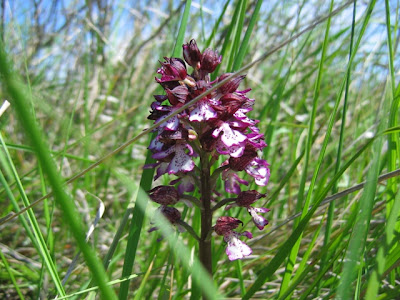French Lady visits English Monkey with a shady Military past
A small group of English monkeys living in Oxfordshire were visited by ladies who either drifted across the Channel or were deliberately transplanted onto English soil. The monkeys and ladies bred, producing monkey-ladies capable of back crossing with the ladies and monkeys.
The English monkeys had a shady past having bred at some distant time with military types, so they were hardly 'pure'.
Now what to do? Should the recently arrived French ladies and their English monkey-lady offspring be expunged? That's the big conservation question presented to us today.
The ladies, monkeys and military are kinds of orchids, and this is the gist of a talk given today by Mike Fay, Head of Genetics at Royal Botanic Gardens, Kew, called 'A bit of monkey business - when is a lady not a lady?'.
The talk was presented by Orchid Conservation International at the Jodrell Laboraory at Kew Gardens.
As Mike put it "the Military, Lady and Monkey Orchids are among the rarest plants in
England and they don’t occur elsewhere in the UK".
They are three species of the genus Orchis. There used to be seven species of Orchis in the United Kingdom and England, but since 1997 (from some work led by fellow Kew botanist Mark Chase) there have been five recognised, with three moved to other genera and one from another genus moved into Orchis. One of the species grows only on the Channel Islands, leaving four in mainland England.
Of these one, the Early Purple Orchid, O. mascula, is widespread throughout the UK and under no immediate threat. It's quite isolated in the genus and doesn't appear to hybridise with any other species.
The Man Orchid, O. anthropomorpha, didn't even figure in my little tale at the start! It's relatively widespread in the south-east of England but is decreasing in extent and may soon be of concern.Where Man and Monkey Orchids coexist there is some interbreeding and hybridisation but the offspring are not fertile (like mules, from horses and donkeys).
The Military Orchid, O.
militaris, was thought to be extinct but rediscovered in the 1940s. It's now known from three populations in England, one with 200 plants and other two smaller. The 200-strong population has very little genetic variability but one of the smaller populations includes only six plants, each genetically distinct and possibly representing separate migrations
from the Continent after the last Ice Age. Yes, French Men crossing the Channel!
The Monkey Orchid, O.
simia, is known in England by one population near Reading, in Oxfordshire, and two in Kent (one natural and one
transplanted).
As I hinted at the start, some of the Monkey
Orchids have a the shadow in their genes of a past liaison with the Military Orchid. In Kent they are more 'pure'.
The genetic work by Mike reveals lots of complicated relationships among the so-called anthropomorphic orchids - the ones that look like men, women, monkeys and military folk.
One of the more interesting discoveries is that the Lady Orchid, O. purpurea, includes a more widespread English population (numerous populations but also decreasing in number over all) as well as a form only known from southern France. It may be that these two should be separated into two species, in due course...
But back to Oxfordshire. In the spot where our Monkey Orchids flourish an interloper arrived a few years back, a Lady Orchid. Not only did it arrive but, as in continental Europe, it started breeding with the local species, resulting in the monkey-ladies.
We don't know whether the Lady Orchid, which Mike can track back to the French form of the species (he calls it a femme fatale), was deliberately planted or grew from seed drifting across the channel (which may or may not be possible).
Just to further complicate things, the first hybrids were confused with Military Orchids but careful observation and genetics confirmed their origin.
So now you know the story. The big question is do we leave the Lady Orchids and the Lady-Monkey Orchid hybrids alone or dig them up? They can and do back cross so we will in time have a very messy mixed population.
Does it matter whether the seed blew in from France or whether the species Homo sapiens carried it? What if a bird carried it? A native or pest bird? So many questions.
The decision was to leave the Lady and Monkey Orchids alone, and to map and identify the hybrids so
they can be dug up later if desired. So for now, the ladies, monkeys and monkey-ladies can live in a kind of harmony.
Image: A French Lady Orchid, perhaps? This is a picture I took in 2008 near Carcassone in southern France.

Comments